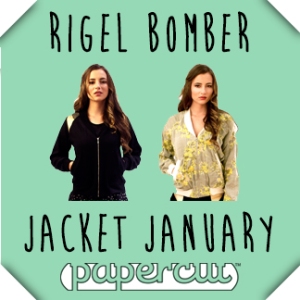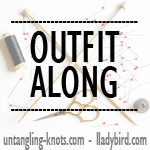The pockets are ready to be sewn on the Burda 02/2009 #115 jacket. I know at least one of the individuals who reviewed this pattern put the pockets on before doing the hem and facing. Burda instructions have you sew the pockets over the hem and facing. This time I decided to go with Burda so the pockets are waiting. I spent a lot of time preparing the pockets because I really want them to be exactly even and the same size. So, I used a variation of a tip from Shannon Gifford. (Note: Her courses on PatternReview are excellent.) She suggests tracing the pocket without seam allowances on cardboard. For these pockets, I used template plastic which, IMHO, is easier for tracing than cardboard. The first step is pinning the pocket pleats on the pattern:

Then, I traced the pocket and flap without seam allowances. The pattern slipped a bit with those pleats pinned so I checked and corrected the tracing. I labeled both pieces, partly because I'm scatterbrained and partly because I may use these tracings for pockets on another garment.

Then, I cut out my traced patterns and used them to iron the seam allowances over them. The ironing was easier and more accurate. I checked my accuracy by folding the pockets and flap at the center mark to make sure both sides were the same. Then, I checked the pockets and flaps to make sure they were the same size. They were! (Before making the pleats and pressing the seams, I added fusible interfacing to the top of the pockets. I do use pockets and want them to be stable.)
Here's my big clinch:

The linen I used has some lycra in it. The fabric must have slipped because the upper sleeveon one side was cut way off grain and hung crooked. I ripped and carefully pinned this sleeve so that it would hang on grain. What a pain! The difference between the upper and lower sleeve is not big so, hopefully, I can just shorten the sleeves a bit and still use the sleeve bands. Naturally, I did not have enough fabric to cut another top sleeve! After the fact, I remembered a tip that I read somewhere (can't remember where) to press fabric with a dry iron, spitz with water, and iron parallel to the selvage. I tried that with a skirt I cut out last weekend. The fabric lies so nicely. I guess I've been steaming the fabric out of shape. That won't happen again!!
The collar is ready. I really worked on it. The points are pretty good but I sure wish I could do them better. I know, from past experience, that the points can only take so much fiddling before a hole appears. I used Pam's tutorial for the collar except that I didn't have to turning tool she used. That tool is on its way to me now.

I had to read the instructions for installing the collar several times. Finally, I figured them out. The front facing is only sewed to the notch for the end of the collar before the collar is sandwiched in between.
 I did pin the CB and shoulder points to check the fit first. We'll have to see how this works.
I did pin the CB and shoulder points to check the fit first. We'll have to see how this works.
Then, I moved on to doing another collar for a shirt that I had cut out. I just had to try that collar again quickly. It was sort of like someone who comes close to drowning in a pool. They had better get right back in (assuming there is no physical damage, of course) and start swimming. Otherwise, a lifelong fear of water can occur. I certainly don't want to have a lifelong fear of pointed collars. Here's my blouse V2634, in process, that I hope to finish this weekend:









2 comments:
Oh those clinchers--doncha' just love em? Sometimes they just make you want to pull your hair out! Looks like you have everything under control though. Nice going!
Do you work on multiple projects at once, like the jacket and the blouse? If so, WOW! you must be super organized. BWOF jacket 115 is such a nice style. Yours is going to look fantastic, especially with all the care you are taking in the construction. Great pocket construction tips. Linen with lycra is a nice combo of natural fiber and stretch, but I too have had problems with one layer stretching while sewing a seam.
Post a Comment